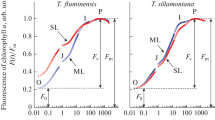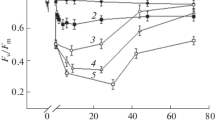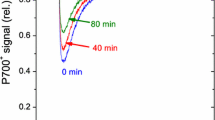Abstract
Measurements of electron transport activity point to the occurrence of major changes in the organisation of the photosynthetic apparatus of heat-stressed chloroplasts. One of the consequences of these changes is shown to be a greatly increased susceptibility of chlorophyll to photobleaching. Despite the fact that the threshold temperature for this photobleaching coincides closely with that for the inhibition of PSII activity, the bleached components were found to be specifically associated with PSI. This increased susceptibility of PSI pigments to photobleaching is shown to be a direct consequence of an interruption of the flow of reductants from PSII to PSI that would normally protect PSI from photooxidation.
Similar content being viewed by others
Abbreviations
- PSI:
-
photosystem I
- PSII:
-
photosystem II
- chl a :
-
chlorophyll a
- chl b :
-
chlorophyll b
- LHCP:
-
chlorophyll a/b light-harvesting protein
- CP1 :
-
P700-chlorophyll a protein
- DCMU:
-
3-(3′4′ dichlorophenyl)-1′1′-dimethylurea
- DCPIP:
-
dichlorophenolindophenol
- Fecy:
-
potassium ferricyanide
- MV:
-
methyl viologen
References
Berry J and Björkman O (1980) Photosynthetic response and adaptation to temperature in higher plants. Annu Rev Plant Physiol 31:491–543
Quinn PJ and Williams WP (1985) Environmentally induced changes in chloroplast membranes and their effects on photosynthetic function. In: Barber J and Baker NR (eds) Photosynthetic Mechanisms and the Environment. pp 1–47, Elsevier, Amsterdam
Katoh S and San Pietro A (1967) Ascorbate-supported NADP photoreduction by heated Euglena chloroplasts. Arch Biochem Biophys 122:144–152
Yamashita T and Butler WL (1968) Inhibition of chloroplasts by UV-irradiation and heat-treatment. Plant Physiol 43:2037–2040
Santarius KA (1975) Site of heat-sensitivity in chloroplasts and differential inactivation of cyclic and non-cyclic photophosphorylation by heating. J Thermal Biol 1:101–107
Krause GH and Santarius KA (1975) Relative thermostability of the chloroplast envelope. Planta 127:285–289
Schreiber U, Colbow K and Vidaver W (1976) Analysis of temperature-jump chlorophyll fluorescence induction in plants. Biochim Biophys Acta 423:249–263
Schreiber U and Berry J (1977) Heat-induced changes of chlorophyll fluorescence in intact leaves correlated with damage of the photosynthetic apparatus. Planta 136:233–238
Schreiber U and Armond PA (1978) Heat-induced changes of chlorophyll fluorescence in isolated chloroplasts and related heat-damage at the pigment level. Biochim Biophys Acta 502:138–151
Armond PA, Björkman O and Staehelin LA (1980) Dissociation of supramolecular complexes in chloroplast membranes. A manifestation of heat damage to the photosynthetic apparatus. Biochim Biophys Acta 601:433–442
Gounaris K, Brain APR, Quinn PJ and Williams WP (1984) Structural reorganisation of chloroplast thylakoid membranes in response to heat-stress. Biochim Biophys Acta 766:198–208
Emmett JM and Walker DA (1973) Thermal uncoupling in chloroplasts. Inhibition of photophosphorylation with no depression of light-induced pH change. Arch Biochem Biophys 157:106–113
Armond PA, Schreiber U and Björkman O (1977) Photosynthetic acclimation in the desert shrub Larrea divaricata. Light-harvesting efficiency and electron transport. Plant Physiol 61:411–415
Stidham MA, Uribe EG and Williams GJ (1982) Temperature dependence of photosynthesis in Agropyron smithii Rydb. I. Factors affecting net CO2 uptake in intact leaves and contribution from ribulose-1,5-bisphosphate carboxylase measured in vivo and in vitro. Plant Physiol 69:929–934
Thomas PG, Quinn PJ and Williams WP (1983) Temperature-induced changes in the structure and function of pea chloroplasts and their relation to chloroplast membrane organisation. In: Sybesma C (ed) Advances in Photosynthesis Research. Vol. 3. 1 pp 35–38. Nijhoff/Junk Publishers, The Hague
Downton WJS and Berry JA (1982) Chlorophyll fluorescence at high temperature. Biochim Biophys Acta 679:474–478
Smillie RM (1979) Coloured components of chloroplast membranes as intrinsic membrane probes for monitoring the development of heat-injury in intact tissues. Austr J Plant Physiol 6:121–133
Gounaris K, Brain APR, Quinn PJ and Williams WP (1983) Structural and functional changes associated with heat-induced phase-separations of non-bilayer lipids in chloroplast thylakoid membranes. FEBS Lett 153:47–52
Stokes DM and Walker DA (1971) Phosphoglycerate as a Hill oxidant in a reconstituted chloroplast system. Plant Physiol 48:163–165
Laemmli UK (1970) Cleavage of structural proteins during the assembly of the head of bacteriophage T4. Nature 227:680–685
Fork DC, Ford GA and Catanzaro B (1978) Measurements with a microprocessor-based fluorescence spectrophotometer made on the blue-green alga Anacystis nidulans above and below the phase transition temperature. Carnegie Inst Wash Year Book 78:196–199
Ridley SM (1977) Interaction of chloroplasts with inhibitors. Induction of chlorosis by diuron during prolonged illumination. Plant Physiol 59:724–732
Murata N, Nishimura M and Takamiya A (1966) Fluorescence of chlorophyll in photosynthetic systems. III Emission and Action Spectra of fluorescence — three emission bands of chlorophyll a and the energy transfer between two pigment systems. Biochim Biophys Acta 126:234–243
Anderson JM (1980) Chlorophyll-protein complexes of higher plant thylakoids: distribution, stoichiometry and organisation in the photosynthetic unit. FEBS Lett 117:327–331
Tremolieres A, Dubacq JP, Ambard-Bretteville F and Remy R (1981) Lipid composition of chlorophyll-protein complexes. FEBS Lett 130:27–31
Pearcy RW, Berry JA and Fork DC (1977) Effects of growth temperature on the thermal stability of the photosynthetic apparatus of Atriplex lentiformis (Torr.). Wats Plant Physiol 59:873–878
Raison JK, Roberts JKM and Berry JA (1982) Correlations between the thermal stability of chloroplast (thylakoid) membranes and the composition and fluidity of their polar lipids upon acclimation of the higher plant, Lerium oleander to growth temperature. Biochim Biophys Acta 688:218–228
Pearcy RW (1978) Effect of growth temperature on the fatty acid composition of the leaf lipids in Atriplex lentiformis (Torr.) Wats Plant Physiol 61:484–486.
Williams WP, Gounaris K and Quinn PJ (1983) Lipid-protein interactions in the thylakoid membranes of higher plant chloroplasts. In: Sybesma C (ed) Advances in Photosynthesis Research, Vol 3, pp 123–130. Nijhoff/Junk, The Hague
Emmett JM and Walker DA (1969) Thermal uncoupling in chloroplasts. Biochim Biophys Acta 180:424–425
Mukohata U, Yagi T, Higashida M, Shinozaki K and Matsuno A (1973) Biophysical studies on sub-cellular particles. VI. Photosynthetic activities in isolated spinach chloroplasts after transient warming. Plant Cell Physiol 14:111–118
Santarius KA (1973) The protective effect of sugars on chloroplast membranes during temperature and water stress and its relationship to frost dessication and heat resistance. Plant a 113:105–114
Santarius KA (1980) Membrane lipids in heat injury of spinach chloroplasts. Physiol Plant 49:1–6
Volger H and Santarius KA (1981) Release of membrane proteins in relation to heat injury of spinach chloroplasts. Physiol Plant 51:195–200
Weis E (1981) Reversible effects of high sublethal temperatures on light-induced light scattering changes and electrochromic pigment absorption shift in spinach leaves. Z Pflanzanphysiol 101:169–178
Weis E (1982) Influence of light on the heat sensitivity of the photosynthetic apparatus in isolated spinach chloroplasts. Plant Physiol 70:1530–1534
Szigeti Z and Vagujfalvi D (1984) Protection of chlorophyll against photobleaching by reductants. Photobiochem Photobiophys 7:103–109
Author information
Authors and Affiliations
Additional information
Biochemistry Department, King's College (KQC), University of London
Rights and permissions
About this article
Cite this article
Williams, W.P., Sen, A. & Fork, D.C. Selective photobleaching of PSI-related chlorophylls in heat-stressed pea chloroplasts. Photosynth Res 10, 75–92 (1986). https://doi.org/10.1007/BF00024187
Received:
Revised:
Issue Date:
DOI: https://doi.org/10.1007/BF00024187




